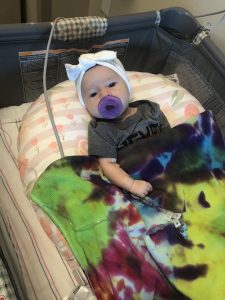From Parents’ Nightmare to Cause for Hope: The Lackey Family on Learning of SMA and Trying Zolgensma

Samantha and Jeremy Lackey with their first child, Stella. (Photo courtesy of Lackey family)
[Editor’s Note: This is the first of a two-part series on the Lackey family of Arizona, whose daughter Stella became the first baby west of Missouri to be treated outside of a clinical trial with Zolgensma on July 3. Here, the family talks about how their daughter came to be diagnosed and getting into Zolgensma treatment.]
A mother’s intuition, a pediatrician’s careful watch, and a lot of help from people across all walks of life came together for a baby girl named Stella Quinn Lackey, born in mid-May with spinal muscular atrophy type 1 and treated with Zolgensma some seven weeks later.
“I don’t want … everyone to think our experience was the norm and what [other parents] should expect,” Jeremy Lackey, Stella’s father, said in interview with SMA News Today from his Arizona office. “We know that we got very, very lucky. Everything worked out in our favor.
“We had so many people in our corner who were making things happen for us.”
But “luck,” he added, is nuanced when it comes in the context of a disease as swift and damaging as SMA, especially type 1, the genetic neuromuscular disorder’s most severe form. And the outcome is months, if not years, away from being known — although Stella, Jeremy and Samantha Lackey’s first child, may be showing encouraging signs.
“It is honestly like someone turned up the volume,” said Samantha, reached at her Phoenix-area home. Stella “previously was very quiet with her cries; she now is a lot louder.”
The couple, both from Chicago and largely unaware of SMA prior to their daughter’s June 18 diagnosis at exactly 1 month old, are “hesitant to kind of say that we’ve seen anything more” in the weeks since her July 3 gene therapy infusion.
Ask questions and share your knowledge of Spinal Muscular Atrophy in our forums.
In a flurry of words, Samantha then added: “She definitely seems to be breathing a lot easier and we’ve seen more movement. … It’s pretty incredible, actually.”
The Lackey’s story is a good, if unusual, one.
Unusual for the speed of Stella’s diagnosis — at birth, she seemed fine; unusual for the speed by which Stella came to the attention of a neurologist, and won insurance approval for the $2.125 million treatment that came a week later. From start to finish — June 18 to July 3 — the process spanned 16 days.
The family wants their story told, because they want to help other parents in taking crucial steps, avoiding some pitfalls, and in pushing for what this disease demands — from doctors who might take a “wait-and-see approach” through to decision-makers hesitating to require that newborns be screened for SMA.
“There are plenty of families and patients who have not been as lucky,” said Jeremy, 28, who works in sales for a logistics company.
‘Trust your gut’
Samantha Lackey, 27, was 13 weeks pregnant when, because her mother had been adopted and knew little of her biologic family’s background, she choose to undergo a genetic test. Its results would show Samantha to be a carrier for SMA, cystic fibrosis and familial cholestasis. She and her husband, who had no reason to think he also was an SMA carrier — neither had any known history of the disease — decided to go ahead with the pregnancy.
They alerted each pediatrician of Samantha’s carrier status.
Stella (named for both great-grandmothers) came into the world on May 18 a perfect little girl, doing well on initial reflex exams and screenings for genetic diseases. In Arizona, as in most U.S. states, however, SMA is not among the more than two dozen heritable diseases included in a statewide newborn screening program.
But at 3 weeks old a blocked tear duct looked to be getting infected, so Samantha took the baby to a pediatrician. And, in what would be a momentous decision, she asked for a different doctor — one who had examined Stella at the hospital when she was 1 and 2 days old, rather than the pediatrician who on an initial office exam told the Lackeys their baby “definitely does not have SMA.”
Both parents “were on top of the world” at hearing those words, Samantha said. But things “just didn’t click” for her with that pediatrician.
Matthew Barcellona, with North Scottsdale Pediatrics, saw Stella again on June 8, for the first time since mid-May. As he spoke about writing a prescription for eye drops, he put Stella through a series of basic reflex tests. He paused after each round, then started the reflex series over again.
“Has she always been lazy?” he asked at one point.
Stella’s parents completely misunderstood. “Yeah, she’s a great baby. She doesn’t give us any fights, she doesn’t scream her head off,” Samantha remembers answering.
Barcellona was worried by the regression he saw in the scant weeks since the hospital reflex exam. “You could see the concern on his face at this point,” said Samantha, who reminded the doctor of her SMA carrier status. Barcellona then asked if the Lackeys would agree to having Stella checked by a neurologist at Phoenix Children’s Hospital. They did, and he began calling for an appointment.
“I’m just doing this out of an abundance of caution,” Samantha remembers the pediatrician telling them. “If this is something they want to see her for today, then you guys go in. If it can wait until Monday, fine. But I want her to be seen.”
She also remembers, with Jeremy, not yet being “too freaked out.”
The appointment was secured that afternoon, and the family was told to expect a hospital stay of several days as a series of tests was likely.
Stella did fine on initial exams, including a brain scan of electrical activity (an EEG) and an MRI. But a test of muscle response to nerve stimulus called an EMG (electromyography), done on “the tail-end of an exhausting weekend,” showed problems.
A genetic test on a blood sample followed. Results, announced by telephone about a week later on June 18, confirmed type 1 SMA in the now month-old girl.
“From people that we’ve connected with and the networking we’ve done via social media and otherwise,” Jeremy said, “there are plenty of families … who might hear from their pediatrician: ‘Well, every baby develops differently. Just give it a couple months and maybe they’ll meet those milestones.’
“If Dr. Barcellona had just told us to keep an eye on it, we’d still be in the dark and waiting for Stella to develop,” he added. “And meanwhile, she’s facing this disease and every day matters.”
The Lackeys’ first piece of advice for parents facing SMA or any serious illness: “Trust your gut, and if you have a feeling, don’t hesitate to explore that,” in Jeremy’s words. His wife, watching her daughter’s eye infection, had a feeling “not that something was wrong, but just that we needed to go to a doctor,” and to a different doctor.
“Follow your instinct,” he added, speaking directly to parents.
After Stella’s confirmed diagnosis, the family went back to thank Dr. Barcellona — and learned then he never before treated an SMA baby. “I gave that man the biggest hug in the world,” Samantha said.
Accept help, and reach out to others
A first appointment with Saunders Bernes, a pediatric neurologist with Barrow Neurological Institute at Phoenix Children’s, came within a day of the diagnosis.
Bernes intended from the get-go to recommend Stella for treatment with Zolgensma, the gene therapy by AveXis and Novartis that won FDA approval for SMA infants and toddlers less than a month earlier. In addition to the test for SMN1 gene mutations that confirmed her SMA, Bernes ordered that Stella’s blood be checked for antibodies to the specific adenovirus (AAV9) used to carry Zolgensma to motor neurons throughout a patient’s system.
Antibodies against the engineered virus that wraps the gene and allows it to move so effectively into the brain and central nervous system, where most motor nerve cells are found, would cause an immune reaction against the therapy. For this reason, an antibody test is an essential early step to treatment.
Both Jeremy and Samantha fully supported his choice.
Zolgensma “won’t replace what she’s lost, but it gives her the opportunity to build” motor neurons that can produce the SMN protein her muscle cells lack and desperately need, her father said.
Bernes also was “clearly concerned about the [disease] progression” evident in the baby. As mid-June began to wane and Stella moved into her fifth week of life, her breathing changed. A video taken the day before treatment shows the 6-week-old prone and unmoving except for her chest, pumping for air. [Readers can follow Stella’s story — in words, photos and video — on her Instagram page: stronglikestella.]
Speaking with parents of SMA children via social media channels, none of whose “kids were eligible to receive Zolgensma” solidified the decision, Jeremy added. “All the parents we talked to … said, ‘If we were given this option, we would do it in a heartbeat. It wouldn’t be a second-guess to us at all.'”
Having channels to reach out to families who knew more than they, and Cure SMA to guide their introduction and send packages with “resources, toys and different things to make Stella comfortable and test her fine motor skills” were another “blessing,” the Lackeys said. The mother of an SMA child in the Chicago area, known to Jeremy’s sister because a sibling attended the school where she taught, was particularly helpful and encouraging.
Bernes and Phoenix Children’s Hospital put the Lackey family in contact with AveXis and its OneGene Program for Zolgensma, and led them through each of its steps. “Everything was directly handled by them … behind the scenes,” Jeremy said.
Bernes also filed for treatment coverage with Samantha’s insurer, Cigna, and received approval that same day, June 23.
“Keeping everything in perspective — the situation, the diagnosis — we’ve been extremely lucky to have the resources available to us,” Jeremy said. “I think a lot of that stems from having Dr. Bernes in our corner.”
Another piece of advice: “Talk with parents that have children with SMA [and discuss options] with your spouse,” Samantha said. “We had some very hard conversations while Stella was in the hospital the first time.
“Talk about what’s best for your child and your family. You can’t put a price on what you are facing.”
Part 2: Treatment day and challenges that lie ahead.










